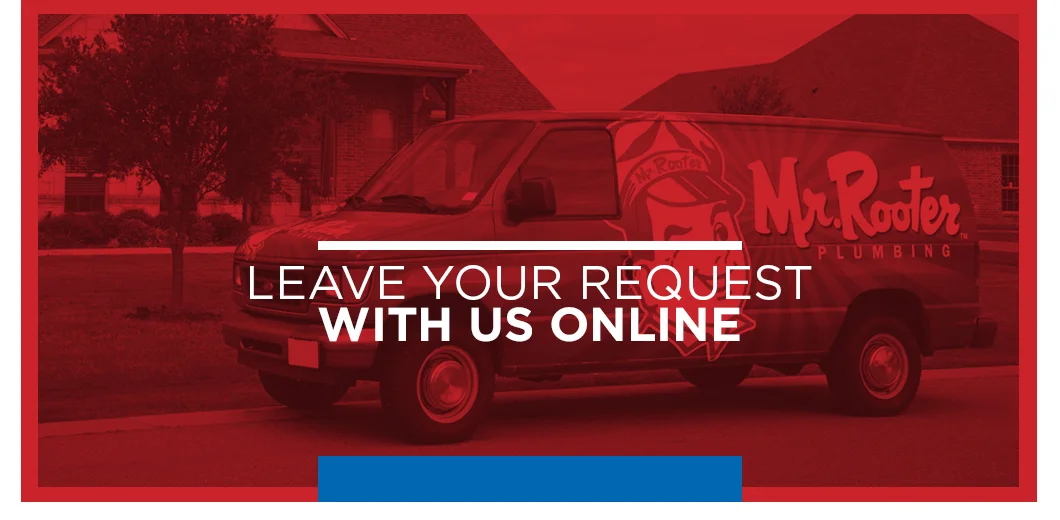
Moving is an opportunity to clear the clutter and make a fresh start in a new Oneida home, but the process can also involve some unexpected challenges. For instance, you'll find it's impossible to pack many of your home appliances into a box and move them without taking precautions. You need to be especially careful with appliances that use water, such as refrigerators, freezers, washers, and dishwashers. Make your move as stress-free as possible with these tips for transporting your freezer and other home appliances.
First, you cannot always trust a moving company to disconnect these appliances from your old home properly and correctly install them in your new location. Some may not even ship your devices if you have not prepared them. You may be able to ready the appliances for moving yourself if you know the exact steps to take and have the time to dedicate to the task. If you lack the time, skills, or tools, though, you can still get professional help from Mr. Rooter Plumbing of Oneida.
Moving can be stressful, but you can make the job a little bit easier by hiring professional movers to tote your boxes of possessions. Did you know professional help for moving your appliances is available, too? To prepare your freezers, refrigerators, and more for a move, our licensed plumbers at Mr. Rooter Plumbing can help, especially with appliances connected to water supplies. We can correctly remove your water connections and ensure your new home has the appliances appropriately installed.
How to Move Various Appliances

Appliances are big, bulky and usually require unique electrical and water connections. Moving one of these from one home into another means you need to know how to carry the bulk and how to transport the appliance safely. If you do not take care, some appliances could become unusable when you reach your destination, leaving you with a costly bill to replace them.
Tips for All Appliances

When moving appliances, take measurements of the device you need to move. Also, get the dimensions of any doors the appliance will need to fit through in both your old and new home. While most new homes have doors wide enough to accommodate modern appliances, some older homes may not have door widths to admit an extra-wide refrigerator-freezer. For example, you may need to remove the door on a freezer to allow it to fit through a smaller doorway.
If your appliances will fit through all spaces in your old and new homes, remove any moving components inside them. Also, tape any doors or drawers shut to keep them in place during transport, and use moving blankets to protect the appliances from dents. Other ways to help keep your devices in good condition when you arrive are specific to the type of machine you are moving.
Tips for Moving Washers
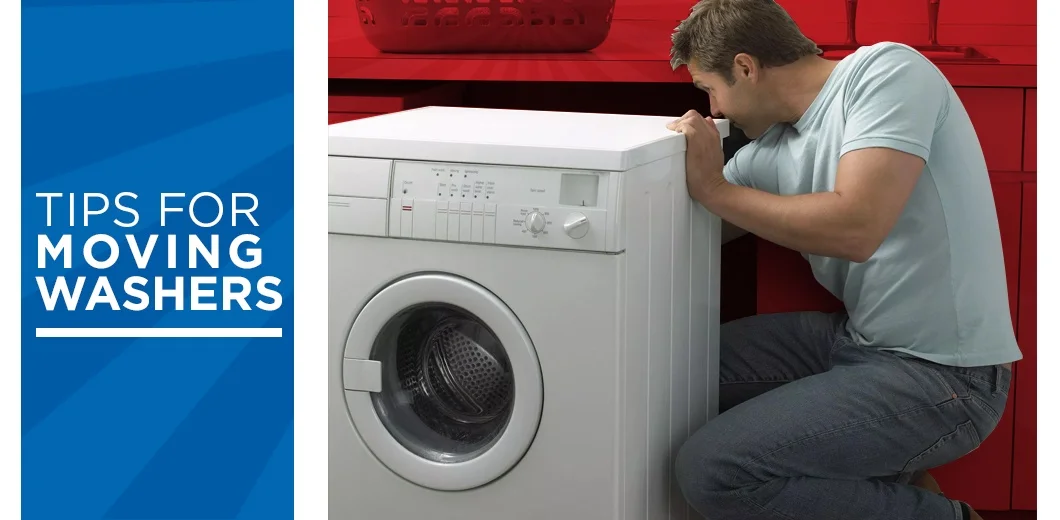
First, you need to see if your washer has any water in the drum from the last cycle. If so, you must drain the water out first. Look in your owner's manual for how to drain a washer for moving. The methods will depend on if you have a front-loading or top-loading model. Drain the washing machine carefully. You may not realize how much water is inside, but your washer could have anywhere between five and 10 gallons of water inside it, especially if it failed to drain from a washing cycle.
Additionally, you must disconnect the hoses. Washing machines typically have two supply hoses — one for hot and one for cold water — and a drain hose. The drain hose is wider than the other two. To remove any water from the machine, shut off the two water supply valves. Then, run the washer for 30 seconds to remove any supply water from the hoses into the tub, and get water out of the drum by running a complete spin cycle. Finally, remove the supply lines from their connections. When disconnecting these hoses, keep a bucket nearby to drain any water still in the lines. Store the drained lines in a safe place. With a clean towel, pat the inside of the washer dry. Doing so will keep mold or mildew from forming inside the appliance.
Unplug the washing machine from the outlet and tape it to the back of the washer. Doing so prevents damage to the cord and plug during the move. Use easily removable packing tape for securing the cord. Also, tape the door closed. Do this for either front-loading or top-loading washers. You do not want the door to open while moving the unit. The movement from an opening door can cause a sudden imbalance in the washer, which could cause the machine to fall off its dolly.
Aside from the cord, you will also need to know how to keep the tub in place. Consult your owner's manual for how to secure the tub. Some washers have designs that require bolting the tub into place. Others need a separate moving kit. If you fail to secure the tub, it could shift too much in transit, causing damage to both the machine and to the tub.
When you get to your new home, you will need to reverse the process to install the new washer. Do not forget to remove the device you used to secure the tub. You may not be able to use the washing machine if you leave that device in place. For the water connections, it will be easier if you consult with a plumber for the installation. Doing so will ensure you have adequate water supply to your machine and the washer's water will drain out correctly.
Tips for Moving Dryers
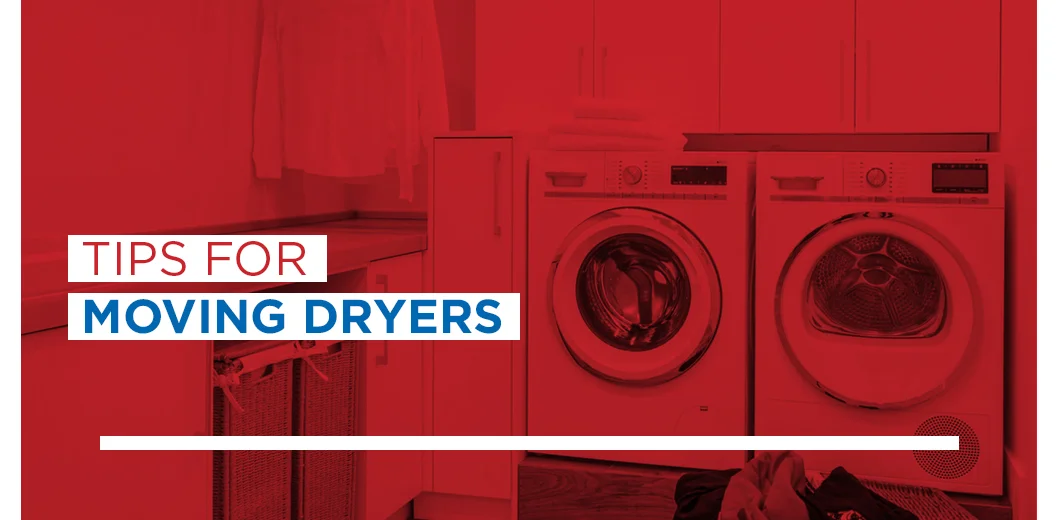
Dryers are slightly easier to move than washers because they do not have water that needs draining, but you could encounter difficulties if you own a gas dryer. When moving a dryer, follow the same protocols you used for your washer to secure the electric cord and door. Unlike a washing machine, a dryer has an air outlet hose that leads to an outside wall of your home, where it releases hot air from the dryer. Remove this hose from both the dryer and its outlet. Store the vent hose in a secure place.
If you have an electric dryer, you have finished your checklist, and the appliance is ready to move. However, if you own a gas dryer, you will need professional help in disconnecting the dryer from the gas supply. Do not attempt to disconnect a gas line on your own. You could experience a gas leak or damage to the gas line to your dryer with a missed step in the process.
Always consult with an expert for disconnecting and installing any gas appliances you have. You may need your gas company to check on your new home after you have moved in to ensure the connections are secure and safe before you have the gas turned on. Call your local utility provider.
Tips for Moving Dishwashers
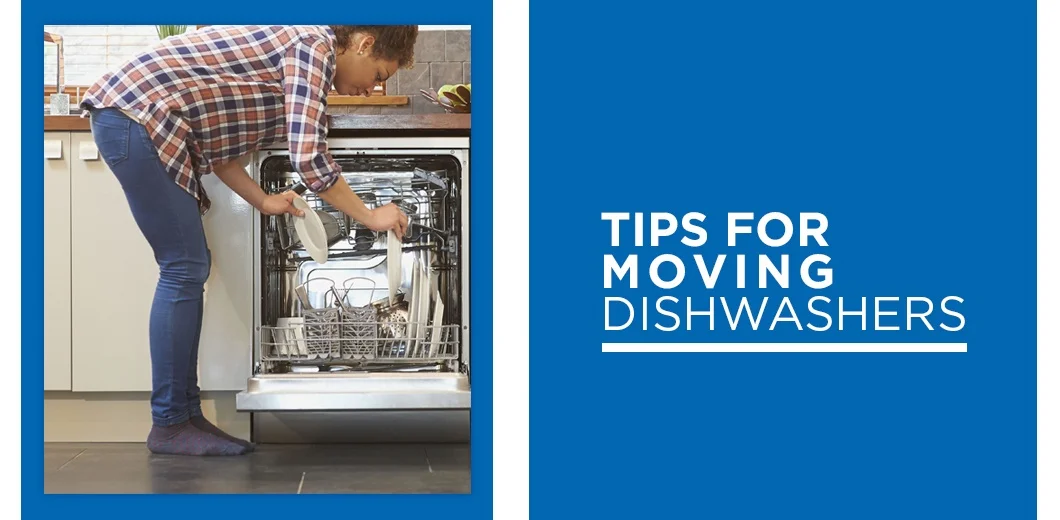
Like a washing machine, dishwashers have plumbing connected to the appliance, including both a water supply to the unit and a drain that connects to your sink. As with your washer, you will need to make sure the unit has completed a cycle and drained thoroughly before disconnecting the water supply, drain hose, and electrical cord.
Before disconnecting the unit, open the door and remove the racks. Leave the dishwasher in this position for at least a few hours until the interior has dried. Use towels to finish drying the interior of the dishwasher and the racks. Removing moisture prevents mold growth.
Remove the supply hoses and drain any water left in them into a bucket. Disconnect the drain hose and allow any water in it to pour out. Separate the hoses from the dishwasher and store them in a safe place after drying them thoroughly.
Tape the door closed after verifying you have completely dried the interior. Also, tape the electrical cord to the back of the unit after unplugging the dishwasher. Failing to tape these components of the dishwasher in place could cause damage to the appliance or other items in transit.
When you arrive at your new home, you may need some assistance installing the dishwasher in your new home. Installing a dishwasher can be tricky, especially if you want to connect the supply and drain lines correctly. How you install the drain line will depend on whether you have a garbage disposal. If you have never installed a dishwasher, contact a plumber, like our licensed professionals, to get the job done correctly the first time. With quality installation of your dishwasher after moving into your new home, you will not have to wait to start using your kitchen.
Tips for Moving Refrigerators
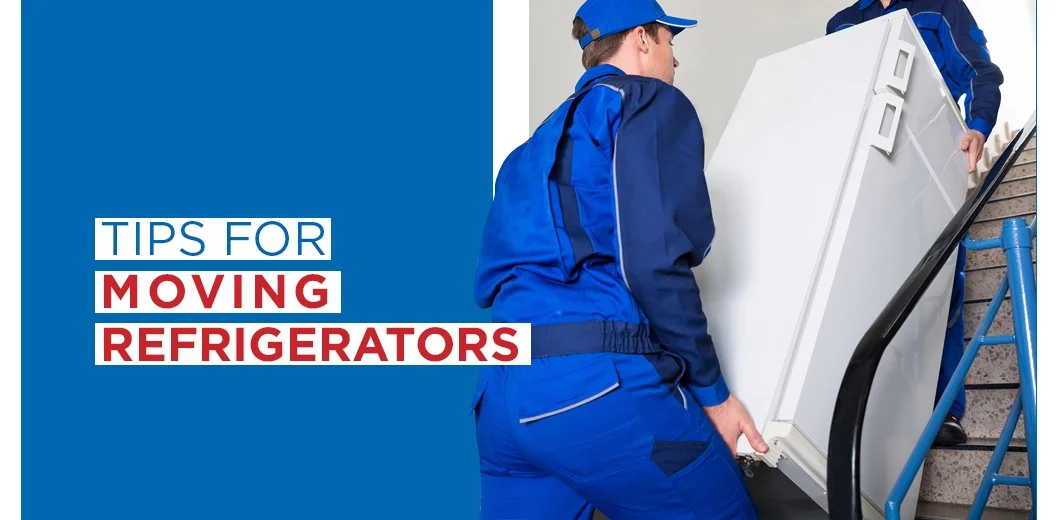
Refrigerators have a design that makes them difficult to move. They are tall, bulky, and heavy. Additionally, refrigerators often have freezer compartments with ice dispensers that have a water connection. To get your refrigerator out of your home easily without damaging the operating system or the icemaker, you will need extra caution during both preparing the appliance and moving a frost-free fridge-freezer.
Refrigerators and freezers both have coolant in them for operation. This refrigerant needs to stay in the system, and tipping a refrigerator can cause contamination of the coolant. Additionally, if you don't defrost your fridge or freezer, moisture from the melting ice can get the refrigerator's working parts wet or cause mold to form inside the unit.
If you are wondering how long to turn off a fridge before moving, use the following tips:
- When you are ready for it to defrost, remove everything from your refrigerator and unplug it.
- Cover the floor with towels to absorb any moisture that comes from the appliance during defrosting.
- Leave the door open and allow at least 24 hours for the refrigerator or freezer to completely thaw inside.
Now is the prime time to clean the interior of your unit. After everything has defrosted, clean the interior with a cleaning solution to freshen it and remove any potential organisms that could breed mold. Additionally, clean and dry the evaporator pan, and remove all shelves and drawers from the refrigerator and freezer. If you have glass shelves, wrap them in moving blankets or towels to prevent breakage. Store the drawers and plastic or wire shelves in a separate box for the move. Separating the racks from the refrigerator prevents them from moving around inside the appliance and scratching the interior.
Thoroughly cleaning your refrigerator is critical for protecting the food you put into it later. Mold spreads through the air via spores, but these spores can also spread on insects or through direct contact. If your refrigerator develops mold during the move, it could contaminate your food.
If your fridge has an icemaker or a water dispenser, call a plumber to have these disconnected and reinstalled when you move. You don't want to lose the convenience of an icemaker and water dispenser as a result of poor installation. Seek assistance from a professional. Even moving companies will recommend you ask a plumber for help for your water dispenser and icemaker.
Hopefully, you have already measured the openings you will move your refrigerator through. If the fridge is too wide to pass through doorways, you may need to remove the doors from the appliance. Moving companies will do this chore for you during the move. If you are moving on your own, always have a toolkit unpacked and ready in case you need to take off table legs, refrigerator doors, or other parts of items to get them through tight spaces.
During transport, do not put some models, such as compact models or those with a freezer drawer and French doors, on their sides. You may transport others, like side-by-side designs or those with the freezer on top, on their sides if there is no option to move them vertically. After the move, keep the refrigerator upright for at least 24 hours before having a plumber reconnect the water dispenser and icemaker.
After getting the icemaker and water dispenser reconnected, do not immediately consume the ice or water from them. You will need to get rid of the first two or three batches of ice because installation dirt could still be in the lines. After the first couple of batches of ice, the ice maker supply lines should be clear of debris enough to start using the ice from the appliance.
The refrigerant system needs to settle properly with the appliance fully upright before it is safe to use, especially if it got tilted or kept on its side during the move. After it has been sitting upright for an appropriate amount of time and you have called your plumber to connect the water and icemaker, you can plug it in and replace the shelves and drawers.
Tips for Moving Freezers

Freezers have a variety of designs, from chest freezers to upright to compact models. As with refrigerators, you have to be careful to keep the unit upright during transport. Freezers use the same type of refrigeration system as refrigerators do, and moving them will require caution to prevent damage to the coils or the coolant inside them.
Clean out any food from the freezer and unplug it. Never try to move a full freezer. A freezer with food adds extra weight, making it harder to move. Also, in many instances, the time after unplugging the freezer until it gets installed in your new home will be too long to preserve any food inside. Food left inside a freezer could spoil, and the moisture from the food could promote mold growth. Avoid these problems by removing all food from your freezer.
Defrost a freezer for moving for at least 24 hours. Thoroughly clean and dry the interior to prevent mold and mildew during transport. Remove and clean off any shelves or bins from the freezer, too. Use tape to secure the electrical cord to the back of the freezer. Also, tape the door of your freezer shut, whether you have an upright or a chest model. Taping the door shut keeps it from opening during the move and damaging other items in the truck.
Depending on your freezer model, you may have an icemaker inside. If you do, do not try to disconnect the icemaker yourself. Hire a professional to do the job. If you do not have your freezer completely disconnected, your moving company may not take it.
As with a refrigerator, if you have an upright freezer that is too wide to fit through a door, you might need to remove the door. Have a supply of tools on hand to do this and replace the door as soon as you can. Moving the door separately from the freezer increases the chances of the interior of the freezer or the door sustaining damage during the move.
When moving the freezer, wrap it in blankets or another form of padding. The padding will protect the exterior of the appliance from damage. Ideally, you should keep your freezer entirely upright the entire time during the move. If you do not have space to transport the freezer upright, place it on the compressor side.
When you reach your destination, if the freezer stayed upright the whole trip, you can plug it in immediately. However, if you had to put it on its side, how long to wait to plug in a freezer after moving depends on how long it was lying down. For instance, if you had to keep the freezer on its side for three hours, allow it to stay upright for at least three hours before plugging it in. Prematurely plugging in a freezer that was on its side could damage the cooling system. You don't have to keep the unit upright for more than 24 hours.
Request a professional for installing your freezer at your new home, too. Icemakers in your freezer require special piping to get water to them. Installing this tubing yourself may be too difficult. Ask us at Mr. Rooter Plumbing to take care of this task for you.
Contact Us at Mr. Rooter Plumbing for Appliance Help During Your Move
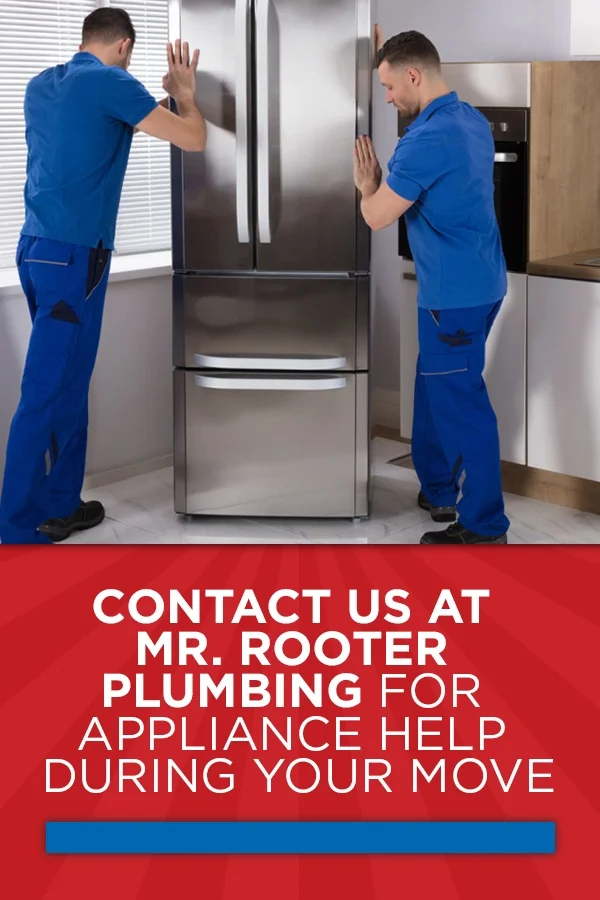
When it comes to moving your appliances, you will need to plan for the event several days in advance. Planning allows enough time for your freezer or refrigerator to defrost properly. Without properly preparing your freezer, refrigerator, and other water-using appliances, you could end up with a mess of water during the move. The most damaging scenario happens when you fail to remove all the water from the appliances and mold begins to grow. Even if you need help disconnecting your washer, dishwasher, or freezer, you can still take the necessary steps for draining appliances for moving to prevent mold.
You are not alone in your move, though. At Mr. Rooter Plumbing, we do more than fix pipes. Our licensed plumbers can help with your water connections for your appliances, whether you are moving in, moving out, or both. The last thing you want is to make a mistake with any plumbing connections. Our experts can help you with any plumbing needs you have, even when moving appliances.
For professional installation or removal of your appliances in Oneida, contact us at Mr. Rooter Plumbing. You can also leave your request with us online, and we will call you. Make your move less stressful by turning over the difficult, time-consuming tasks of moving your appliances. At Mr. Rooter Plumbing, we will help you in your move to your new home, so the only thing you need to do is get comfortable in your new space.
